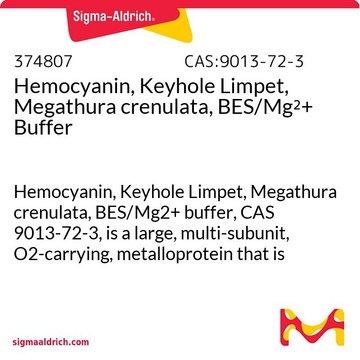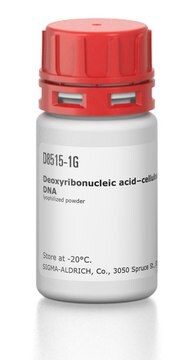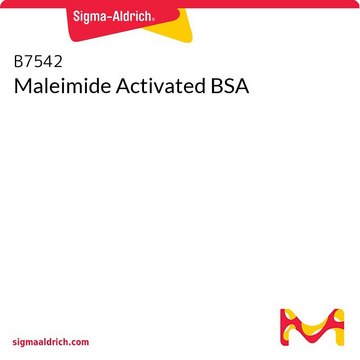H8283
Hemocyanin from Megathura crenulata (keyhole limpet)
PBS solution
Synonim(y):
KLH, Keyhole limpet hemocyanin
Zaloguj sięWyświetlanie cen organizacyjnych i kontraktowych
About This Item
Polecane produkty
pochodzenie biologiczne
Megathura crenulata
Poziom jakości
Formularz
PBS solution
stężenie
3.0-7.0 mg/mL protein (A280)
zawartość miedzi
0.10-0.30% (based on protein)
metody
ELISA: suitable
temp. przechowywania
2-8°C
Szukasz podobnych produktów? Odwiedź Przewodnik dotyczący porównywania produktów
Opis ogólny
Gastropod hemocyanins are massive glycoproteins (4 to 8 MDa) designed by an intricate arrangement of 10 subunits that are self-assembled into hollow cylinders 35 nm in diameter.
Hemocyanin is a high molecular weight copper containing glycoprotein. It reversibly binds oxygen and forms the extra-cellular respiratory protein of mollusks. Keyhole limpet hemocyanin (KLH) is filtered from the hemolymph of Megathura crenulata, also called the giant keyhole limpet. It is native to the southern California coast and Mexico.
Zastosowanie
Keyhole limpet hemocyanin (KLH) is a strong and well known immune-stimulant in both experimental animals and humans. It has been used as a hapten carrier protein to enhance antigen-specific T cell priming and is known to stimulate a CD4+ T-cell response.
Hemocyanin was used to study if antipeptide antibodies specifically recognize the l1 protein of the human papilloma virus of type 31. It was also used to study the acid-induced unfolding of didecameric keyhole limpet hemocyanin.
Hemocyanin was used to study if antipeptide antibodies specifically recognize the l1 protein of the human papilloma virus of type 31. It was also used to study the acid-induced unfolding of didecameric keyhole limpet hemocyanin.
Postać fizyczna
Solution in PBS, pH 7.2, containing 1mM CaCl2 and 0.5 mM MgCl2 with 15 mM sodium azide as preservative
Uwaga dotycząca przygotowania
Chromatographically purified.
Ta strona może zawierać tekst przetłumaczony maszynowo.
Kod klasy składowania
10 - Combustible liquids
Klasa zagrożenia wodnego (WGK)
WGK 3
Temperatura zapłonu (°F)
Not applicable
Temperatura zapłonu (°C)
Not applicable
Wybierz jedną z najnowszych wersji:
Masz już ten produkt?
Dokumenty związane z niedawno zakupionymi produktami zostały zamieszczone w Bibliotece dokumentów.
Klienci oglądali również te produkty
Ankita Varshney et al.
Amino acids, 39(3), 899-910 (2010-03-10)
Keyhole limpet hemocyanin (KLH) is widely used as an immune stimulant and hapten carrier derived from a marine mollusc Megathura crenulata. To provide details of the stability and equilibrium of KLH, different intermediate species were investigated with a series of
Hendrikus J Wijnen et al.
Frontiers in veterinary science, 8, 784869-784869 (2022-01-01)
Resilient animals can cope with environmental disturbances in life with minimal loss of function. Resilience can be enhanced by optimizing early-life conditions. In poultry, eggshell temperature (EST) during incubation and early feeding are two early-life conditions that are found to
S M Andreev et al.
Bioorganicheskaia khimiia, 38(6), 667-675 (2013-04-04)
Antibodies that specifically recognize the capsid protein (L1) of human papillomavirus (HPV) are an important tool necessary for designing vaccines against HPV infection. In this work, we have predicted and synthesized peptide fragments mimicking B cell epitopes of L1 HPV
L R Ferguson et al.
Mutation research, 158(1-2), 89-95 (1985-10-01)
The tannins, delphinidin and procyanidin were isolated from flowers of white clover (Trifolium repens) and the leaves of Arnot Bristly Locust (Robina fertilis) respectively, and tested for mutagenic properties in a range of systems. There was no evidence for either
Traumatic aneurysm of the internal carotid artery with fracture dislocation at C 5: case report.
H Wada et al.
Neurosurgical review, 12 Suppl 1, 600-601 (1989-01-01)
Nasz zespół naukowców ma doświadczenie we wszystkich obszarach badań, w tym w naukach przyrodniczych, materiałoznawstwie, syntezie chemicznej, chromatografii, analityce i wielu innych dziedzinach.
Skontaktuj się z zespołem ds. pomocy technicznej







